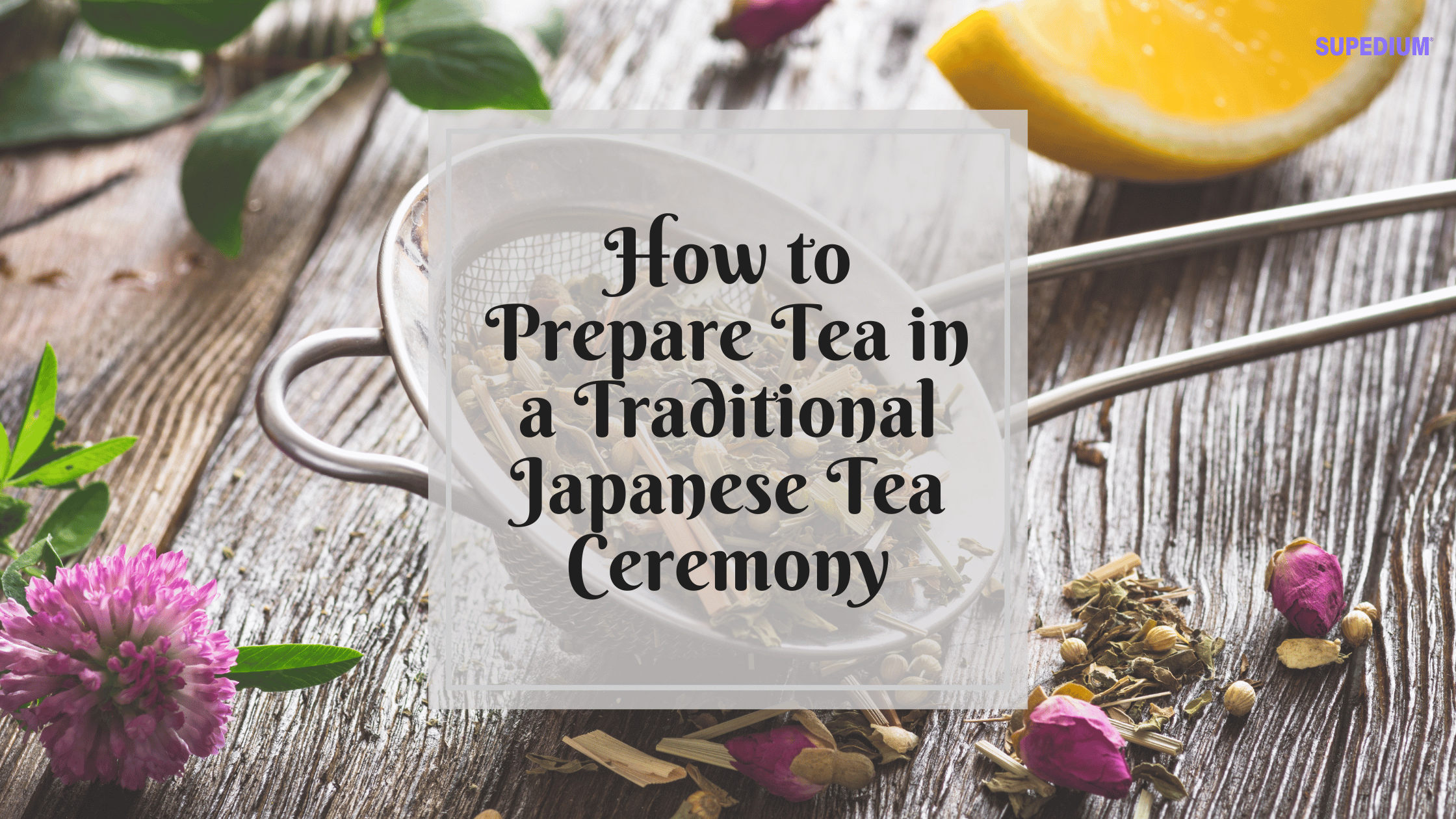Table of Contents
- 1 Key Elements of the Japanese Tea Ceremony
- 2 Essential Tools and Utensils Used in the Ceremony
- 3 Preparing the Tea Room and Atmosphere
- 4 The Step-by-Step Process of Preparing Tea in a Traditional Japanese Tea Ceremony
- 5 The Rituals and Etiquette in the Japanese Tea Ceremony
- 6 The Conclusion of the Tea Ceremony
- 7 Conclusion
![]()
The Japanese tea ceremony, known as chanoyu, chado, or sado, is a highly ritualized practice that goes beyond simply making tea. Rooted in Zen Buddhism, the ceremony is an expression of hospitality, mindfulness, and respect. Preparing tea in this traditional way involves more than just brewing a cup—it’s a spiritual experience that embodies principles of harmony, tranquility, and appreciation of the present moment. This article will walk you through the essential components of the tea ceremony, the tools used, and the step-by-step process of preparing tea in this revered tradition.
Key Elements of the Japanese Tea Ceremony
The Principles of the Tea Ceremony
At the heart of the Japanese tea ceremony are four key principles: harmony (wa), respect (kei), purity (sei), and tranquility (jaku). These principles guide the entire process, from preparing the tea to the interaction between the host and the guests. The ceremony is intended to create an atmosphere of mutual respect and peacefulness, where the ordinary becomes extraordinary.
Another central concept is ichi-go ichi-e, which translates to “one time, one meeting.” This philosophy teaches that every tea ceremony is unique, and each moment should be cherished as a once-in-a-lifetime experience. The fleeting nature of time is honored through the ceremony’s careful rituals and mindfulness.
Setting and Atmosphere
The tea ceremony takes place in a specially designed space, often called a chashitsu (tea room). This room is minimalist and serene, typically furnished with tatami mats, wooden or bamboo utensils, and seasonal decorations. The space is arranged thoughtfully to create a calming environment that helps participants focus on the present moment.
Part of the tea ceremony experience is the seasonal decoration, often involving a flower arrangement or a calligraphy scroll, known as a kakemono. These elements change throughout the year, reflecting the seasons and adding an ever-present sense of change and beauty.
The Role of the Host and Guests
The host’s role is central to the tea ceremony. They are responsible for the preparation and serving of tea, ensuring the process is conducted with grace and mindfulness. The host must be attuned to the guests’ needs and feelings, guiding the ceremony with a calm and measured demeanor.
The guests, in turn, are expected to show respect for the host and the tea, participating in the ceremony with full awareness and appreciation. The exchange of bows and appropriate etiquette are critical in maintaining the ceremony’s reverence.
Essential Tools and Utensils Used in the Ceremony
The Japanese tea ceremony employs a specific set of utensils that are carefully selected and maintained. Each tool has a distinct role in the preparation and serving of tea.
Chawan (Tea Bowl)
The chawan is the tea bowl used to serve matcha during the ceremony. It is not just a practical tool, but also an aesthetic object. The size, shape, and design of the chawan are important, and guests should handle it with care, appreciating its craftsmanship. Typically, the tea bowl is rotated to avoid drinking from its front.
Chasen (Bamboo Whisk)
The chasen is a bamboo whisk used to mix matcha powder and hot water. The whisking action is essential for creating a smooth, frothy texture. The chasen is held with both hands, and the whisking motion is done with a careful wrist movement to produce the desired consistency.
Chashaku (Bamboo Scoop)
The chashaku is a bamboo scoop used to measure the matcha powder. It is typically used to transfer 1-2 scoops of powdered tea into the chawan. The amount of matcha is crucial for the strength and flavor of the tea.
Natsume (Tea Caddy)
The natsume is the container used to store the powdered matcha. It is usually made of lacquered wood and is designed to keep the tea powder dry and free from contamination. The caddy is handled delicately, and the host will open it carefully during the ceremony.
Kensui (Waste Water Bowl)
The kensui is a bowl used for discarding waste water during the ceremony, such as the water used to rinse the tea utensils or any tea left over. It keeps the tea space clean and symbolically represents the purity that is a key part of the tea ceremony.
Fukusa (Silk Cloth)
The fukusa is a silk cloth used by the host to clean utensils, such as the chawan, chasen, and chashaku. This act of cleaning symbolizes purification and attention to detail, both of which are crucial elements of the tea ceremony.
Preparing the Tea Room and Atmosphere
Cleaning and Arranging the Space
Before the ceremony begins, the tea room must be thoroughly cleaned. This ritual cleaning is a form of purification, preparing the space for the ceremony and creating a sense of clarity and focus. The utensils are arranged in a precise and aesthetic manner on the tatami mats, contributing to the beauty and balance of the space.
Seasonal Decor
One of the key features of the Japanese tea ceremony is the seasonal decoration. The kakemono, a scroll with calligraphy or a painting, is often displayed, and seasonal flowers or plants are arranged in the room. This reflects the Japanese appreciation for the changing seasons and adds a living, organic element to the ceremony.
Welcoming the Guests
The host welcomes the guests with deep respect, and the ceremony begins with the exchange of bows. The host ensures that the guests are comfortable and that they understand the proceedings, inviting them into a space of mindfulness and appreciation.
The Step-by-Step Process of Preparing Tea in a Traditional Japanese Tea Ceremony
Step 1: Preparing the Tea Utensils
The host begins by carefully cleaning the tea utensils with the fukusa. This act of cleaning is performed in a deliberate and respectful manner, emphasizing the importance of purity and attention to detail.
Step 2: Measuring the Matcha
The host uses the chashaku to scoop powdered matcha into the chawan. The amount of matcha is important, typically 1-2 scoops, depending on the type of tea being prepared. The matcha is added with care and precision to ensure the correct strength of the tea.
Step 3: Adding Hot Water
Hot water, typically heated to around 70-80°C (160-175°F), is poured into the chawan with attention to the temperature. The water is added slowly to avoid disturbing the delicate balance of the matcha powder.
Step 4: Whisking the Matcha
The host then uses the chasen to whisk the matcha and water together. The whisking motion is performed with a back-and-forth action to create a frothy, smooth tea. The whisking should be steady and even, with the host maintaining a calm and controlled pace.
Step 5: Serving the Tea
Once the tea is prepared, the host presents the chawan to the guest. The bowl is carefully rotated so that the guest receives it with the proper side facing them. The guest is expected to receive the tea with respect and gratitude, acknowledging the host’s efforts.
Step 6: Drinking the Tea
The guest then rotates the chawan before sipping the tea, ensuring they do not drink from the front. They take small sips and savor the flavor. After drinking, the guest may wipe the rim of the bowl with their fingers, appreciating the taste and the craftsmanship of the tea.
The Rituals and Etiquette in the Japanese Tea Ceremony
The Role of Silence and Mindfulness
Silence is an important element of the tea ceremony. The focus is on mindfulness—being present and attentive to the moment. The stillness encourages guests to reflect and appreciate the beauty in the simple act of tea preparation and consumption.
Proper Bowing and Gestures
Bowing is a central gesture in the tea ceremony. The host bows to show respect for the guests, and the guests bow in return to express gratitude. Every action, from holding the bowl to sipping the tea, is performed with grace and awareness.
Appreciation and Acknowledgement
Guests are encouraged to express their appreciation of the tea, the bowl, and the entire ceremony. This acknowledgment is not only of the tea’s flavor but also of the host’s effort and the beauty of the moment.
The Conclusion of the Tea Ceremony
Closing the Ceremony
The ceremony typically concludes with the host cleaning the utensils and offering a final expression of gratitude. The guests also acknowledge the host’s hospitality and leave with a sense of calm and fulfillment.
Reflecting on the Ceremony’s Significance
The tea ceremony is more than just making tea—it is an expression of mindfulness, beauty, and respect. Through each step, participants are reminded of the transient nature of time and the value of every moment.
Conclusion
The traditional Japanese tea ceremony is a practice of profound simplicity and elegance. From the careful preparation of tea to the mindful interactions between host and guest, every element of the ceremony reflects the deep cultural values of respect, harmony, and tranquility. For those who take part in it, the ceremony offers a rare opportunity to connect with the present moment and appreciate the fleeting beauty of life. Whether as a participant or an observer, experiencing the tea ceremony is a unique way to understand and appreciate Japanese culture and its deep respect for nature, craft, and the ritual of sharing tea.
Share This





Be the first to comment